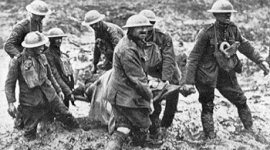
THE IMAGE WHICH CANNOT BE ERASED
A new genre of extreme violence has emerged on social media which renders impotent any restrictions in broadcasting
TV news in the UK is subject to careful editorial control when covering violence. Its parameters are the subject of vigorous debate because the stakes are so high: the greater the trauma, the greater the public clamour for political action. TV newsrooms are full of the most hideous images of warfare which could quickly alter public opinion were they to be broadcast.
Those who argue for less editing claim that the sanitising of war leads to apathy among the viewing public. This was especially felt during the Balkans wars – before the era of humanitarian intervention – when some reporters wanted more graphic scenes of violence to be shown as a way of stirring governments into action over the horrors of ethnic cleansing. Those who resist a loosening of the controls are worried scenes of extreme violence are viscerally felt and that people may lack a wider context in which to interpret what they are witnessing, thus leading to skewed public policy.
On balance the British public is probably very grateful for existing controls. The Arab world was shown graphic images of the unspeakable death of Jordanian pilot Moaz al-Kasasbeh at the hands of Isis, which only heightened the moral outrage felt. It is unlikely anyone who has seen this clip is easily going to erase it from their minds and most would resist Piers Morgan’s belief that we have a duty to watch it to clarify our feelings about the perpetrators.
Isis uses social media to terrorise, compel over-reaction where it is useful and divide coalitions. Yet there is a new genre being played out on social media more generally, a pornography of violence which renders impotent any restrictions on broadcast TV news. It may have begun with the filmed murder of Ken Bigley in 2004 by al-Qaeda in Iraq, the forerunner of Isis. YouTube was inundated by people choosing to watch the scene, many of them living in Britain. Since then, it has become a cynical tool of degradation and recruitment. Concerns about the depiction of real violence on the news or fictional violence in the movies may have become redundant; unregulated images of extreme cruelty on social media are becoming the new norm.
There are private and public responses to make. We dehumanise people by watching films of them being tortured or murdered, we dishonour the victims’ families and we demean ourselves. It allows images to become ingrained in our minds which cannot be deleted as easily as a smart phone picture gallery. Scenes are memorialised which affront human dignity and anger God.
The Apostle Paul encouraged a Christian response to what assails us in life. In Philippians, while he was being maltreated by captors, he said:
Finally, beloved, whatever is true, whatever is honourable, whatever is just, whatever is pure, whatever is pleasing, whatever is commendable, if there is any excellence and if there is anything worthy of praise, think about these things (4:8)
There remains a paradox for Christians, nevertheless. Our salvation is predicated on an act of extreme violence and we are encouraged to interpret the cross in our discipleship. Thank God the crucifixion is a matter of believing, not of seeing.
POPULAR ARTICLES

Obama's Covert Wars
The use of drones is going to change warfare out of all recognition in the next decades.

Through A Glass Starkly
Images of traumatic incidents caught on mobile phone can be put to remarkable effect.

What Are British Values?
Is there a British identity and if so, what has shaped the values and institutions that form it?


